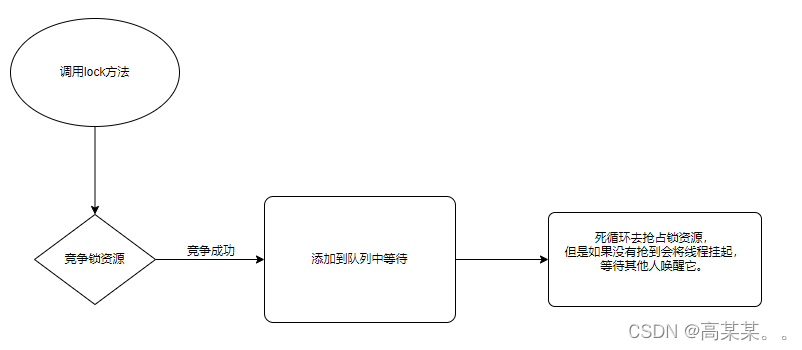首先先观察AQS AbstractQueuedSynchronizer里面的一些属性 我们会用到:
//没有注释的属性暂时不用看
//内部双向链表的头节点
private transient volatile Node head;
//尾节点
private transient volatile Node tail;
//一个锁的状态为 0代表没有上锁 >0代表上了锁
private volatile int state;
//这个是我们的AQS中的静态内部类 主要是一个双向链表
static final class Node {
static final Node SHARED = new Node();
static final Node EXCLUSIVE = null;
//该节点失效的标志位
static final int CANCELLED = 1;
//说明该节点的后继节点需要被唤醒的标志位
static final int SIGNAL = -1;
//暂时了解
static final int CONDITION = -2;
//暂时不了解
static final int PROPAGATE = -3;
//这个里面装的就是上面的标志位
volatile int waitStatus;
//标志该节点的下一个节点
volatile Node prev;
//标志该节点的上一个节点
volatile Node next;
//该节点所占用的线程
volatile Thread thread;
Node nextWaiter;
final boolean isShared() {
return nextWaiter == SHARED;
}
//获取该节点的上一个节点
final Node predecessor() throws NullPointerException {
Node p = prev;
if (p == null)
throw new NullPointerException();
else
return p;
}
//构造方法
Node() {
}
Node(Thread thread, Node mode) { // Used by addWaiter
this.nextWaiter = mode;
this.thread = thread;
}
Node(Thread thread, int waitStatus) { // Used by Condition
this.waitStatus = waitStatus;
this.thread = thread;
}
}
接下来我们看ReentrantLock里面的一个NonfairSync 非公平锁:
为什么叫非公平锁 你看代码 一上来 队列都不进直接就开始抢锁了
//这个给sync类是继承我们的AQS的
static final class NonfairSync extends Sync {
private static final long serialVersionUID = 7316153563782823691L;
//这个方法是上锁操作
final void lock() {
//这里是一个CAS操作 修改State状态为从 0 修改为 1 标志我们需要占用锁资源
//注意 这里修改的state不是Node节点的state 而是AQS中的state状态标志位 标志有无人占用锁资源
if (compareAndSetState(0, 1))
//就将exclusiveOwnerThread设置为当前线程 这个属性是AQS的父类AbstractOwnableSynchronizer的一个属性
//private transient Thread exclusiveOwnerThread;
setExclusiveOwnerThread(Thread.currentThread());
else//如果失败 失败的情况就是发生了并发操作 表示有人提前占用锁资源
acquire(1);
}
protected final boolean tryAcquire(int acquires) {
return nonfairTryAcquire(acquires);
}
}
进入上面的Acquire方法种查看:
这个方法主要是重新获取锁资源 如果无法获取 就将当前线程放入队列中并且将线程挂起
public final void acquire(int arg) {
//第一步调用我们的tryAcquire方法 传入参数为1 尝试重新获取锁资源
if (!tryAcquire(arg) &&
//说明前面获取锁资源失败了 我们会放入到队列中去等待
acquireQueued(addWaiter(Node.EXCLUSIVE), arg))
selfInterrupt();
}
进入tryAcquire方法中去看(它直接调用nonfairTryAcquire方法)这里面标志了一个很重要的点,如果将AOS的exclusiveOwnerThread设置为我们使用的线程,同时state>0则表明我们拿到了锁
//非公平锁来尝试获取锁资源
final boolean nonfairTryAcquire(int acquires) {
//获取当前线程
final Thread current = Thread.currentThread();
//获取当前的状态位 是否有人竞争锁资源的状态位
int c = getState();
//如果是0代表没有线程获取到了锁资源
if (c == 0) {
//修改状态位从 0 -> 1
if (compareAndSetState(0, acquires)) {
//修改成功 将属性值修改位当前线程 上面有这个方法 解释过了
setExclusiveOwnerThread(current);
return true;//返回true
}
}
//如果当前有线程获取到了锁资源 查看这个线程是否和我们的线程一致
else if (current == getExclusiveOwnerThread()) {
//如果是同一个线程 那么将state的值+1 因为是可重入锁 所以同一个线程是可以进入的
int nextc = c + acquires;
//这个就是指 +1过后值超过int可以表达的最大范围了 一个健壮性的判断
if (nextc < 0)
throw new Error("Maximum lock count exceeded");
//修改状态位
setState(nextc);
//返回true
return true;
}
//如果上面两个都没有成功 返回false代表获取锁资源失败
return false;
}
查看放入addWaiter放入队列等待的方法:
//锁资源获取失败 添加到队列中等待
private Node addWaiter(Node mode) {
//新建一个node节点 里面是当前线程 和一个mode 其实这个参数就是null Node.EXCLUSIVE
Node node = new Node(Thread.currentThread(), mode);
//我们需要知道这个方法实在AQS中的方法 所以获取的tail就是整个队列的尾节点
Node pred = tail;
//如果尾节点是null 证明这个队列是空队列 没有放任何东西
if (pred != null) {
//我们传入节点的前驱节点指向整个队列的尾节点
node.prev = pred;
//cas来修改整个队列的尾节点位我们传入的节点
if (compareAndSetTail(pred, node)) {
//之前的尾节点的next节点指向我们传入的节点
pred.next = node;
return node;
}
//其实这整个操作就是一个修改队列的尾部节点的操作
}
//重复修改尾节点
enq(node);
return node;
}
观察enq方法:
private Node enq(final Node node) {
//整体就是一次无限循环 直到我们修改尾节点成功
//死循环
for (;;) {
//获取尾部节点
Node t = tail;
//尾部节点为空
if (t == null) {
//将头节点设置为一个新建的节点 这个节点里面是没有任何参数的 相当于一个哨兵
if (compareAndSetHead(new Node()))
//头尾都指向这个个节点
tail = head;
//而且没有返回值 证明它还会循环一次进入下面的方法体
} else {
//不为空证明之前修改尾节点失败
node.prev = t;
//重新指向操作
if (compareAndSetTail(t, node)) {
t.next = node;
return t;
}
}
}
}
放入队列过后 会执行下一个操作,我们已经执行了addWaiter操作了:acquireQueued(addWaiter(Node.EXCLUSIVE), arg)
等待被唤醒 来抢夺我们的锁资源
final boolean acquireQueued(final Node node, int arg) {
//设置一个标志位
boolean failed = true;
try {
//标志位
boolean interrupted = false;
//死循环
for (;;) {
//获取当前节点的前驱节点
final Node p = node.predecessor();
//如果前驱节点和我们队列的头节点相同 继续尝试和我们之前的获取锁资源或者锁重入操作
if (p == head && tryAcquire(arg)) {
//设置为头节点的操作
setHead(node);
p.next = null; //帮助GC回收垃圾 让他不指向任何对象GCroot不可达
//failed标志位false 说明没有失败
failed = false;
//返回interrupted 默认是false 表示不用中断线程
return interrupted;
}
//
if (shouldParkAfterFailedAcquire(p, node) &&
parkAndCheckInterrupt())//执行线程挂起操作 返回值是当前线程是否中断 但是他会暂停在park的地方 直到有人把该线程唤醒
interrupted = true;
}
} finally {
//如果failed为true就代表失败了 上述只有很少的可能才会failed=true,一般都是方法中出现抛异常此操作 取消这个任务的操作
if (failed)
cancelAcquire(node);
}
}
========================================================================================
setHead方法:
//置空的原因是我们的thread已经放入了exclusiveOwnerThread属性中,已经不需要再次保存了 它已经持有了锁
private void setHead(Node node) {
//当前节点设置为头节点
head = node;
//同时将他的thread属性置空
node.thread = null;
//前驱节点置空
node.prev = null;
}
========================================================================================
shouldParkAfterFailedAcquire方法:
//检查当前节点的前驱节点是否有效 如果是SIGNAL直接返回true
//如果如果是无效就将该节点前面的无效节点全部从队列中剔除
private static boolean shouldParkAfterFailedAcquire(Node pred, Node node) {
//获取前驱节点的状态位
int ws = pred.waitStatus;
//如果前驱节点的标志位是SIGNAL 表明它的后继节点 就是该节点需要被唤醒
if (ws == Node.SIGNAL)
return true;
//如果标志位>0 只有CANCELLED 这种情况 表明前驱节点失效了
if (ws > 0) {
//循环查找前驱节点状态位不是CANCELLED 的节点
//查找的同时修改我们的指针
do {
node.prev = pred = pred.prev;
} while (pred.waitStatus > 0);
//找到了该节点把它的next指向我们的当前节点
pred.next = node;
//整体就是一个让我们的当前节点去修改它的前驱节点 把无效的节点剔除队列
} else {
//如果前驱节点的状态位是 -2 或者 -3 的话 就将他修改为-1
compareAndSetWaitStatus(pred, ws, Node.SIGNAL);
}
//后面两种情况执行完后会返回false
return false;
}
========================================================================================
parkAndCheckInterrupt方法:
private final boolean parkAndCheckInterrupt() {
LockSupport.park(this);//将当前线程挂起
return Thread.interrupted();//返回线程是否中断
}
========================================================================================
cancelAcquire方法:
private void cancelAcquire(Node node) {
//健壮性的判断
if (node == null)
return;
//设置当前节点的thread属性为null
node.thread = null;
//得到当前节点的前驱节点
Node pred = node.prev;
//如果前驱节点是CANCELLED状态 就继续向上找 匆匆队列中剔除这些出错的节点
while (pred.waitStatus > 0)
node.prev = pred = pred.prev;
//这个前驱节点的next指向的节点 注意:并不是当前节点 因为还没有赋值操作
Node predNext = pred.next;
//当前节点的标志位设置为CANCELLED 因为已经进入了取消认任务的方法 标志当前任务可以不用执行了
node.waitStatus = Node.CANCELLED;
//如果当前节点是AQS队列的尾节点 进行CAS修改队列尾节点指向我们之前获取的有效的那个前驱节点
if (node == tail && compareAndSetTail(node, pred)) {
//指向成功后将该前驱节点的next置为null,因为它已经是尾节点了
compareAndSetNext(pred, predNext, null);
} else {
//当我们的当前节点并不是尾节点
int ws;
//如果前驱节点不是头节点
if (pred != head &&
((ws = pred.waitStatus) == Node.SIGNAL ||//前驱节点的状态位为SIGNAL或者是状态位位 -2 -3 只要不为CANCELLED 我们吧它的状态位修改位SIGNAL
(ws <= 0 && compareAndSetWaitStatus(pred, ws, Node.SIGNAL))) &&
pred.thread != null)//前驱节点的线程属性不为空表明它还没有执行任务 {
Node next = node.next;//获取我们node节点的next属性
if (next != null && next.waitStatus <= 0)//找到一个节点状态位不为CANCELLED将他作为该前驱节点的后继节点 剔除中间的状态位为CANCELLED的节点
compareAndSetNext(pred, predNext, next);
} else {
//其他情况 从尾部开始找可以启动的节点 唤醒该节点的线程
unparkSuccessor(node);
}
node.next = node; //方便GC回收垃圾
}
}
========================================================================================
private void unparkSuccessor(Node node) {
//获取当前节点的状态位
int ws = node.waitStatus;
//如果状态位不是CANCELLED
if (ws < 0)
//修改为0
compareAndSetWaitStatus(node, ws, 0);
//当前节点的后继节点
Node s = node.next;
//如果后继节点是空 或者 后继节点的状态位是CANCELLED
if (s == null || s.waitStatus > 0) {
//s指向null
s = null;
//从尾节点开始寻找前驱节点 如果找到的节点为null 或者是 node节点 才停止
for (Node t = tail; t != null && t != node; t = t.prev)
if (t.waitStatus <= 0)//如果不是CANCELLED
s = t;//将s指向该节点
}
//如果
if (s != null)
LockSupport.unpark(s.thread);//将该节点的线程唤醒
}
一个非常简化的非公平锁流程图:

